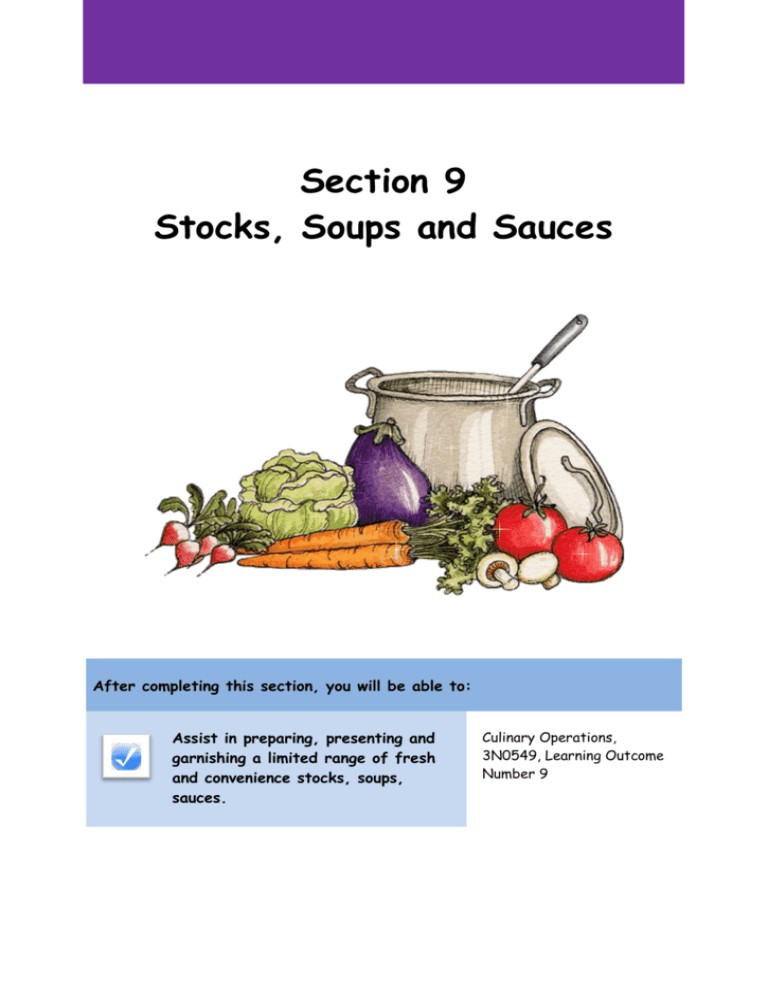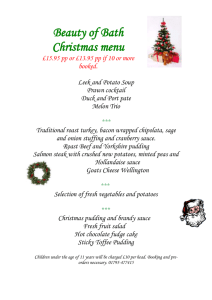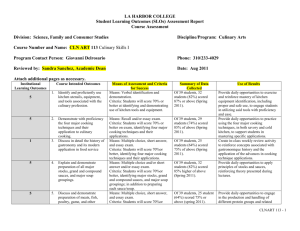Stocks, soups and sauces
advertisement

Section 9 Stocks, Soups and Sauces After completing this section, you will be able to: Assist in preparing, presenting and garnishing a limited range of fresh and convenience stocks, soups, sauces. Culinary Operations, 3N0549, Learning Outcome Number 9 Culinary Operations, 3NO549, LO 9: Assist in preparing, presenting and garnishing a limited range of fresh and convenience stocks, soups, sauces Stocks, soups and sauces Stock Stock liquor is a base of water into which the flavour from bones and vegetables is extracted by a gentle boiling process. Once the cooking time is complete the resulting liquor is stock. Other flavours can be infused into the stock from basic flavourings such as herbs. Steps for making stock The following are steps to follow for making stock. 1. Choose fresh ingredients. 2. Scrape any bones to remove fat. 3. Chop the bones to allow their flavour to become fully extracted. 4. Place the ingredients in cold water (rather than hot). 5. Use clean equipment to prevent food spoilage from harmful bacteria and dirt. 6. When the mixture has boiled, skim to degrease it. 7. Simmer. 8. Do not season stocks. 9. Once the stock is cooked and full of flavour, strain it into a clean pot. 10. Bones and vegetables should not be left in stock as they can re-absorb the flavour and make the stock cloudy. Types of stock There are three types of stock: 1. Brown stock 2. White stock 3. Fish stock 155 Culinary Operations, 3NO549, LO 9: Assist in preparing, presenting and garnishing a limited range of fresh and convenience stocks, soups, sauces 1. Brown Stock Ingredients 5 litres cold water 1.5 Kg selected bones 500g Mirepoix (chopped carrots, celery and onions) Bouquet garni Mushroom trimmings Tomato trimmings Method 1. Brown the bones in a moderate oven 2. Brown the vegetables (avoid burning which causes a bitter flavour) 3. Place the ingredients in a clean pot 4. Bring slowly to the boil, skim and degrease 5. Add bouquet garni and trimmings 6. Simmer for three to six hours (the longer you simmer, the more flavour is extracted) 7. Remove any scum and degrease throughout the cooking 8. After the full flavour has been extracted, strain the stock 2. White Stock White stock is made using the same procedure as brown stock but omitting the browning process. Meat bones are blanched and refreshed before use. 3. Fish Stock Ingredients 5 litres cold water 2.5kg fish bones, washed 250g sliced onions 250g butter Lemon juice Parsley stalks, peppercorns, bayleaf Method For fish stock, follow the same method that is used for preparing brown stock. However, simmer for only 20 minutes. 156 Culinary Operations, 3NO549, LO 9: Assist in preparing, presenting and garnishing a limited range of fresh and convenience stocks, soups, sauces Soups Soups are liquid dishes, typically made by boiling, for example, meat, fish, or vegetables in stock or water. Traditionally, soups are classified into two main groups: clear soups and thick soups. This table outlines the categories of soups and examples of soups in those categories. Clear soups Thick soups Broth Unstrained soup prepared from a stock base, flavoured and garnished by vegetables, fish, meat and cereals. Purée soups A type of soup thickened by either the main ingredient or by a thickening agent such as rice, lentils or potatoes. Examples: Scotch Broth Minestrone Examples: Purée of Lentil Purée of Carrot Purée of Potato Consommé Refined clear soup prepared from a rich stock base. Cream soups Passed soup which has flour as the main thickening agent. Example: Chicken Consommé Examples: Cream of Celery Cream of Asparagus Cream of Leek Provided another example of your choice. Bisque Shellfish soup that is puréed traditionally thickened by rice. Examples: Crab Bisque Lobster Bisque 157 Culinary Operations, 3NO549, LO 9: Assist in preparing, presenting and garnishing a limited range of fresh and convenience stocks, soups, sauces It is recommended that more substantial soups be served for lunch and the more delicate at dinner. Recommendations are listed below. Mealtime Soup types Lunch Purées Creams Broths Brown Soups Dinner Consommé Creams Veloutes Bisques Some guidelines for making soups Some guidelines for making soups are as follows. 1. Use delicious liquids - Use delicious liquids as the base. Soups are mostly water, but you can use broth or stock, wine or milk. Whatever the liquid in your soup is, use one that you would like to drink yourself. To make a good base for your soup you can use any of the following: canned soups, such as tomato or mushroom or cream of chicken, canned tomatoes or tomato juice, canned chicken broth, homemade stocks, commercial soup bases, oxo-type cubes or powders. 158 Culinary Operations, 3NO549, LO 9: Assist in preparing, presenting and garnishing a limited range of fresh and convenience stocks, soups, sauces 2. Sweat the aromatics for flavour - Aromatics include onions, leeks, garlic, and often celery and carrots. Cooking them over low-to-medium heat in the pan before adding any liquid helps to soften their texture and blend their flavours. Cook, stirring occasionally until they are soft but not brown for about five minutes. The goal is to break down their cellulose (making them easier to eat or purée later) and get them to give off some of their liquid, which will deepen the flavour of the soup. Peel and chop onions as uniformly as you can so they cook evenly. Clean and chop leeks to remove grit. 3. Use the right tools - Technically all you need to make soup is a heat-proof vessel and heat. However, if you want to make great soups, make sure you have a large and heavy pot, a powerful blender or immersion blender and an ample soup ladle. 4. Add salt in layers - Add salt to soup as chefs do: in layers. Add some salt to the aromatics and other vegetables as you cook them. If you're cooking the meat separately, make sure it is well-seasoned before it goes into the pot. Most importantly, taste it before serving and add salt until you taste a hike-up in flavour, then stop. 5. Hit your soup with freshness - Add a bit of something fresh right at the end, for example, fresh herbs, fresh citrus juice, or some cream or yogurt. A hit of something un-cooked and un-simmered will highlight any deep flavours in the rest of the soup. 6. Use vegetable trimmings - Use vegetable trimmings for economic soup production. 7. Add vegetables in order - Add the vegetables to your soup in the order of the time it takes to cook them. Carrots, onions and potatoes first, zucchini, fresh corn, frozen peas, etc. during the last 10 minutes. 159 Culinary Operations, 3NO549, LO 9: Assist in preparing, presenting and garnishing a limited range of fresh and convenience stocks, soups, sauces 8. Always cover - Always cover your soup during cooking to reduce evaporation. 9. Garnish well - Go beyond chopped parsley and freshly ground black pepper (although they both make great garnishes for many soups!). Chefs know that the best soup garnishes offer a contrasting flavour or texture to both compliment and highlight the soup. The following are recommended. Crunchy on smooth (small croutons or crackers on a silky leek soup) Smooth on chunky (sour cream on borscht) Bitter on savoury (herbs or black pepper on lentil soup or almost anything!) Salty on sweet (diced prosciutto on sweet potato carrot soup) 10. Reduce fat content - To reduce the fat content, make soup the day before you eat it, chill and scrape off the fat that rises to the top. If you don't have time to chill the soup, use an unprinted paper towel to soak up oil from the surface. 11. Freeze - Freeze your soups to use when needed. 160 Culinary Operations, 3NO549, LO 9: Assist in preparing, presenting and garnishing a limited range of fresh and convenience stocks, soups, sauces Sauces Sauces are widely used in cooking in every type of cuisine from all over the world. Sauces have many different purposes, including: adding moisture and extra flavour accompanying a cut or few slices of meat forming an integral part of the dish livening up salads and cold meats (for example, cold sauces or dressings). Sauces are not always savoury. Sweet sauces such as chocolate sauce, butterscotch sauce, brandy sauce or the versatile custard are poured over desserts in order to add flavour and substance. Certain fruits are blended and pureed and used to accompany sweet desserts or cooked meats. The base of a sauce is some form of liquid which can be milk, stock, wine or a vegetable or fruit juice. The base liquid is thickened with a thickening agent such as flour, fat, eggs, cream, arrowroot or cornflour. Some sauces are cooked and then reduced until the required consistency and thickness has been formed. Sauces can be prepared by whisking, blending or cooking. The majority of sauces are of French origin. The word ‘sauce’ is actually a French word which means a relish that makes food more attractive. In modern cooking of French origin there are five basic sauces that are the basis for nearly every other sauce. These are: 1. 2. 3. 4. 5. Béchamel or White Sauce Velouté or Blond Sauce Espagnole or Brown Sauce Hollandaise or Butter Sauce Tomato or Red Sauce 161 Culinary Operations, 3NO549, LO 9: Assist in preparing, presenting and garnishing a limited range of fresh and convenience stocks, soups, sauces Most other sauces are derived from one of these basic sauces that every cook should know how to prepare. There are other sauces that do not fall into any of the above categories. 1. Béchamel Sauce This common white sauce uses roux (mixture of wheat and fat) to thicken milk or cream. The roux is cooked for about 3 minutes to keep it ‘white.’ To keep the sauce lump-free, remove the roux from the heat before stirring in the milk. Warm the milk in the microwave before adding to the roux. This will also spare the muscles in your hand, as you won't have to stir the sauce so long before it comes to a boil. Use a whisk to incorporate the milk into the roux and stir until it is lump free. Return to the heat source and bring to a boil. Home cookbooks advise just boiling the sauce for 1 minute to cook out the flour flavour. Professional cookbooks encourage you to reduce the heat after bringing the sauce to a boil and then to continue to simmer the sauce for 15-30 minutes, stirring to remove the flour taste. What you actually do will depend upon your time limit and personal tastes. Sometimes a béchamel sauce can be lumpy. The following are common reasons for this: χ χ χ Not beating it enough before cooking Bringing it to the boil too quickly Not stirring it enough during cooking so that it sticks to the bottom of the pan To repair the sauce, pour it through a strainer or process the sauce in a blender. Return the strained or blended sauce to a clean pan and heat to the boiling point. 162 Culinary Operations, 3NO549, LO 9: Assist in preparing, presenting and garnishing a limited range of fresh and convenience stocks, soups, sauces The recipe below makes white sauce of medium thickness. For a thinner sauce, use 1 tablespoon butter to 1 tablespoon flour. For a thicker sauce, use 3-4 tablespoons butter to 3-4 tablespoons flour. Béchamel can be stored in the refrigerator for up to 1 week. Béchamel Sauce recipe (Basic White) Makes 1 cup Ingredients 30 grms butter 30 grms flour 1/2 teaspoon salt Pinch pepper 250ml milk, warm Method Melt the butter in a saucepan over low heat. Blend in flour, salt, and pepper. Cook over low heat stirring until mixture is smooth and bubbly. This is called a white roux. Remove from heat. Stir in warm milk and whisk until mixture is smooth and is free of lumps. Return to heat. Bring to a boil stirring constantly. Boil for at least one minute. 2. Velouté Sauce Velouté sauce is a thinner, lighter white sauce than béchamel. This is because it uses chicken or fish stock instead of milk or cream. Ideally, the consistency of velouté should be thin enough to pour or a sauce that thinly coats the back of a spoon. It is served over chicken, fish, veal or with rice. It is often referred to as a ‘blonde sauce’. 163 Culinary Operations, 3NO549, LO 9: Assist in preparing, presenting and garnishing a limited range of fresh and convenience stocks, soups, sauces Since it is so similar to béchamel, be sure to read the tips relating to béchamel preparation. If you find that after cooking your velouté is too thin its possibly you didn't use enough flour, added too much liquid, or didn't reduce (simmer) the sauce long enough. Either reduce the sauce further or thicken with kneaded butter. If your sauce is flavourless, check what quality of stock you used. Perhaps your sauce has not reduced enough for the flavours to concentrate? You can either perk up your sauce with a dash or two of lemon juice (or other seasonings) or reduce it further to bring out more flavour. You can store velouté in the refrigerator for up to three days or in the freezer for up to one month. Velouté recipe Makes 1 cup Ingredients 500ml chicken or fish stock 45 grms butter 45 grms flour Pinch of salt Pinch of ground white pepper Method Bring the stock to a boil, then set it aside. Melt butter in a 2-quart saucepan over low heat. Create a roux by whisking in the flour. Cook over a medium heat, stirring continually for two to three minutes until the roux is bubbly and begins to darken slightly. Remove from heat. Whisk in the stock until smooth. Return to medium heat and bring to a boil, whisking continuously. Reduce heat. Simmer uncovered for 5-30 minutes. Season with salt and pepper to taste. Set over a double boiler filled with warm water until ready to serve. If not serving right away, dab butter on top of the sauce to prevent a skin from forming. Variation: Supreme Sauce (to serve over chicken) Stir 1/2 cup thinly-sliced mushrooms and 2 tablespoons heavy cream into a heated velouté sauce. Simmer gently for about 10 minutes stirring often to prevent sticking. Strain the sauce into a clean pan set over medium heat. Whisk or swirl in the chilled butter, a teaspoon at a time. Remove from the heat. Add lemon juice to taste. Season to taste with salt and pepper. 164 Culinary Operations, 3NO549, LO 9: Assist in preparing, presenting and garnishing a limited range of fresh and convenience stocks, soups, sauces 3. Espagnole or Brown Sauce For hearty meat entrées, noodles, and wild meat (like bear or venison), brown sauce outshines other sauces. In addition, it is used to create more complex sauces. The technique to master when making this sauce is the browning of the flour or the creation of a dark roux. By using clarified butter, you eliminate the possibility of the butter turning bitter or of burning before the flour has browned. If you prefer to use regular butter however, just watch it closely. To make a dark roux, melt the butter in the saucepan. Remove from the heat and stir in the flour until smooth. Continue cooking over medium heat for 8 minutes, stirring constantly or until the mixture becomes chestnut brown. This sauce freezes well for up to 3 months. Basic Brown Sauce recipe Makes 3 cups Ingredients 40 grms clarified butter 1 large carrot, scrubbed and chopped 1 stalk celery, chopped 2 large onions, chopped 45 grms flour 6 cups brown stock 1 clove garlic, crushed 1 bouquet garni 50 grms tomato puree 165 Culinary Operations, 3NO549, LO 9: Assist in preparing, presenting and garnishing a limited range of fresh and convenience stocks, soups, sauces Method In a heavy saucepan, melt butter over medium heat. Add vegetables. Sauté until golden but not brown. Add in the flour and stir over low heat. Cook, stirring occasionally until flour and vegetables are well-browned but not burnt. Stir in stock. Add garlic, bouquet garni and tomato puree. Simmer for 60 minutes or until the sauce is reduced to half, stirring occasionally. Strain, cool, chill and skim off any fat before using. 4. Hollandaise Sauce Served warm over eggs, fish or vegetables. Hollandaise is a hot emulsified egg-yolk sauce. In mayonnaise, egg yolks are whisked with other room-temperature ingredients. Mayonnaise is a cold emulsified egg-yolk sauce. However, with hollandaise the yolks are whisked with liquid over heat. When making hollandaise, the trick is to cook the sauce ever so slightly without curdling the eggs. Simmer water in a double boiler – it should never be allowed to touch the bottom of the bowl in which the sauce is made. The temperature of the water should never rise above 65 C/150 F. You don't want the sauce to be too hot because it will coagulate the eggs and make it impossible for the butter to emulsify with the liquid. If in spite of all your efforts to monitor the heat, your eggs and liquid cook too quickly, the sauce may separate. This can also happen if you add the butter too briskly. However, you don't have to throw out the sauce, just start again reserving the separated sauce for the clarified butter. Over low heat in a double boiler, beat 1 egg yolk with 15mls of water until light. Remove from the heat and stream in the separated sauce mixture gradually while whisking. Be aware though that if your eggs have coagulated, your sauce cannot be reused. Toss it and begin again with much lower heat! 166 Culinary Operations, 3NO549, LO 9: Assist in preparing, presenting and garnishing a limited range of fresh and convenience stocks, soups, sauces If your sauce is too thin after you've completed all the steps, you may have not reduced the initial liquid enough or added enough butter. To remedy, add more butter. Hollandaise should be served warm. To keep it that way, place the sauce in a bowl. Set the bowl over a pan of hot water (just barely over lukewarm), ensuring the bowl bottom doesn't touch the water. If hollandaise is spooned onto really hot food, the sauce may separate; for this reason, it is almost always served separately from the food it is to complement. Store any extra sauce in the refrigerator. You can use it as a sandwich spread. It should never be reheated. Hollandaise is the basis for rich sauces like béarnaise sauce, which complements meats and salmon. The technique to master in making hollandaise also serves in making sabayon sauces (a light, airy sauce, often served with desserts). Hollandaise Sauce recipe Makes 3 cups Ingredients 4 tablespoons water 1 tablespoon white wine vinegar 1 teaspoon peppercorns, crushed 4 egg yolks 1 cup unsalted butter, clarified, cooled to room temperature 1 tablespoon lemon juice Salt to taste Method In a small pan bring the water, vinegar and peppercorns to a simmer over low heat. Continue simmering until the mixture reduces about a third (about 2-3 minutes). Strain the reduction into a glass or stainless steel bowl, then cool. Place the bowl over a pan of just-simmering water. Add the egg yolks and stir until the mixture is lemon-coloured, thickened and smooth. Keep the heat low. Do not allow the mixture's temperature to rise above room temperature or the eggs may coagulate. Slowly pour in the cooled, clarified butter, stirring constantly until the sauce becomes thick and fluffy. Stir in the lemon juice and salt. When the whisk is lifted from the sauce a ribbon of sauce should trail down from the whisk. 167 Culinary Operations, 3NO549, LO 9: Assist in preparing, presenting and garnishing a limited range of fresh and convenience stocks, soups, sauces Stocks, soups and sauces Vocabulary stock liquor infuse extract ingredients degrease bouquet garni mirepoix strain blanch simmer broth purée consommé bisque substantial veloutes evaporation translucent oregano 168 Culinary Operations, 3NO549, LO 9: Assist in preparing, presenting and garnishing a limited range of fresh and convenience stocks, soups, sauces Stocks, soups and sauces Worksheets These worksheets are based on: Culinary Operations, 3N0549, Learning Outcome 9 Assist in preparing, presenting and garnishing a limited range of fresh and convenience stocks, soups, sauces. 169 Culinary Operations, 3NO549, LO 9: Assist in preparing, presenting and garnishing a limited range of fresh and convenience stocks, soups, sauces Stocks, soups and sauces – Worksheet 1 – Quiz Answer the following questions. 1. List five guidelines for making stock. 1.__________________________________________________ 2.__________________________________________________ 3.__________________________________________________ 4.__________________________________________________ 5.__________________________________________________ 2. List three soups that you have made. 1.__________________________________________________ 2.__________________________________________________ 3.__________________________________________________ 170 Culinary Operations, 3NO549, LO 9: Assist in preparing, presenting and garnishing a limited range of fresh and convenience stocks, soups, sauces 3. Name the five basic sauces 1.__________________________________________________ 2.__________________________________________________ 3.__________________________________________________ 4.__________________________________________________ 5.__________________________________________________ 4. What is a roux? __________________________________________________ __________________________________________________ 5. Give the names of dishes that each of the following sauces can accompany. Sauce Dish Béchamel Velouté Mayonnaise 171 Culinary Operations, 3NO549, LO 9: Assist in preparing, presenting and garnishing a limited range of fresh and convenience stocks, soups, sauces Stocks, soups and sauces – Worksheet 2 – Vocabulary Create a sentence using each of the keywords below which makes its meaning clear. If you want, work with other learners or your tutor. Ingredients Degrease Stock Simmer Strain Consommé Broth Evaporation Garnish Purée Bisque Bouquet garni Roux Clarify Emulsify 172





